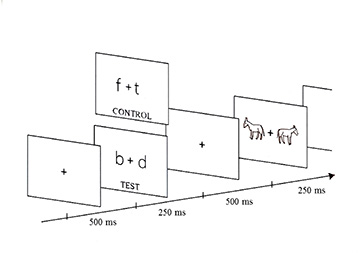When learning to read, our brain must be able to inhibit the mirror-generalization process, a mechanism that facilitates the recognition of identical objects regardless of their orientation, but also prevents the brain from differentiating letters that are different but symmetrical. In recent years, many studies on the process of learning to read have been based on the neuronal recycling hypothesis: the reuse of old brain mechanisms in a new adaptive role - a kind of "biological trick." Specifically, neurons that are originally dedicated to the rapid identification of objects in the environment, through the mirror-generalization process, are "re-purposed" during childhood to specialize in the visual recognition of letters and words.
In a study conducted by the researchers of the Laboratoire de Psychologie du Développement et de l'Education de l'Enfant (CNRS / Université Paris Descartes / Université de Caen Basse-Normandie), researchers showed 80 young adults pairs of images, first two letters and then two animals, asking them to determine whether they were identical. The readers consistently spent more time determining that two animal images, when preceded by mirror-image letters, were indeed identical.

In the experimental sequence, a pair of identical animals (e.g. horses) is preceded on the screen by a pair of mirror-image letters (b and d), or, in the control condition, a pair of non-mirror-image letters (f and t). The participant must decide in each case whether the two items (letters or animals) are identical or not. ©Laboratoire de Psychologie du Développement et de l'Éducation de l'Enfant - LaPsyDÉ (CNRS/Université Paris Descartes, Sorbonne-Paris-Cité /Université de Caen Basse-Normandie)
This increase in response time is called "negative priming": the readers had to inhibit the mirror-generalization process in order to distinguish letters like b/d or p/q. They then needed a little more time to reactivate this strategy when it became useful again to quickly identify animals.
The results show that even adults need to inhibit the mirror-generalization process to avoid reading errors.
Children must therefore learn to inhibit this strategy when learning to read. A failure of cognitive inhibition during the recycling of visual neurons in the brain could thus be a factor in dyslexia - a direction worth exploring in light of these findings, the authors say.
Citation: Grégoire Borst, Emmanuel Ahr, Margot Roell, and Olivier Houdé, 'The cost of blocking the mirror-generalization process in reading: Evidence for the role of inhibitory control in discriminating letters with lateral mirror-image counterparts', Psychonomic Bulletin&Review, 23 May 2014. DOI: 10.3758/s13423-014-0663-9. Source: CNRS (Délégation Paris Michel-Ange)





Comments